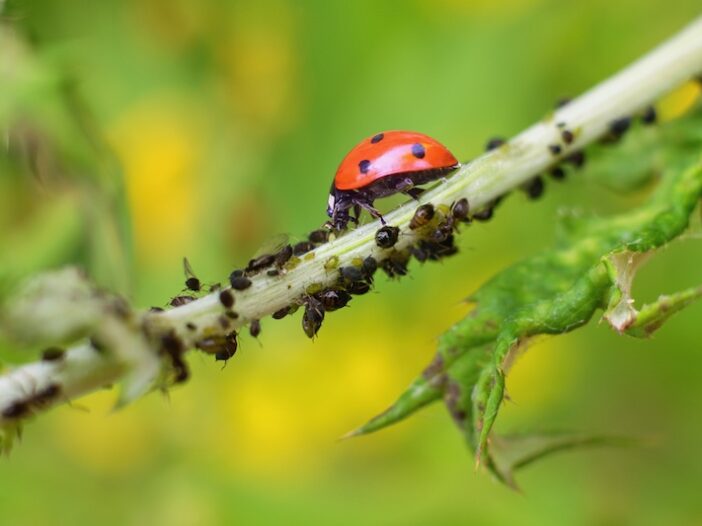
It’s back-to-school time and stores are crammed with backpacks and lunchboxes featuring the latest movie characters and fan favorites. While these trendy icons come and go each year, other embellishments have staying power—like the ladybug. The cute round shape, bright red body, and black polka dots have splashed across kids’ (and adults!) wear and products forever but have you considered why ladybugs deserve our awe? It’s high time your friends at Northwest Pest Control shared what makes ladybugs so fascinating.
Ladybugs are easily recognizable and easy to spot because they live across the U.S. and Canada, anywhere there’s lots of vegetation. Regular sightings give rise to their popularity. Once you see one, what’s not to love? You’re most likely to see ladybugs in the spring and early summer when the warmer months bring them out of hibernation, ready to mate and lay eggs.
Warm, sunny days are prime times for them to hunt aphids and other pests, which is why you’ll see them in gardens and orchards. Their penchant for pests that might otherwise destroy growing fruits and vegetables makes ladybugs heroes among farmers. One ladybug can eat dozens of aphids each day. They also like to feed on other soft-bodied insects like whiteflies, mites, and mealybugs.
The ladybug is a natural pest control. A field or forest full of ladybugs will likely not need chemical pest control and that’s a big win for the environment.
Encouraging ladybugs in your garden can help maintain a balanced ecosystem, promoting biodiversity by controlling pest populations without harming other species.
And if natural pest control wasn’t enough, ladybugs also contribute to pollination. They aren’t quite as adept at pollination as bees, but as they hunt plant to plant they take along a bit of pollen, spreading the wealth. The final benefits of ladybugs are that their unique coloring adds a bit of character to any garden and in some places, ladybugs are viewed as good luck and who can’t use some of that?
However, it’s not all sunshine and goodness with ladybugs.
During the fall and winter months, ladybugs hibernate, often gathering in large groups in sheltered places such as under leaves and crevices. The downside is they might also choose to spend winter in your house.
Here’s how to control and manage ladybugs inside:
1. Prevent Entry
- Seal Cracks and Gaps: Inspect your home for cracks, gaps, or holes, especially around windows, doors, and the foundation. Caulk, weatherstripping, or other sealants can block these entry points. Door sweeps are also effective barriers.
- Install Screens: Ensure windows, vents, and chimneys have tightly fitted screens to prevent ladybugs from entering.
2. Remove Ladybugs Humanely
- Vacuuming: Use a vacuum cleaner with a hose attachment to gently remove ladybugs from inside your home. Be sure to empty the vacuum outside immediately to release the ladybugs without harming them.
- Sticky Traps: Place non-toxic sticky traps in areas where ladybugs congregate. These traps can help reduce their numbers without using chemicals.
3. Repel Ladybugs
- Light Traps: Ladybugs are attracted to light. Light traps lure them and then you can release them outside.
- Herbal Repellents: Natural repellents like bay leaves, clove oil, or citrus-scented sprays can help deter ladybugs.
By taking these steps, you can manage ladybug populations inside your home effectively while allowing them to continue their beneficial role in your garden and yard. If you have a severe ladybug infestation, contact the professionals at Northwest Pest Control. We can offer more targeted solutions to keep ladybugs out of your home without harming them.